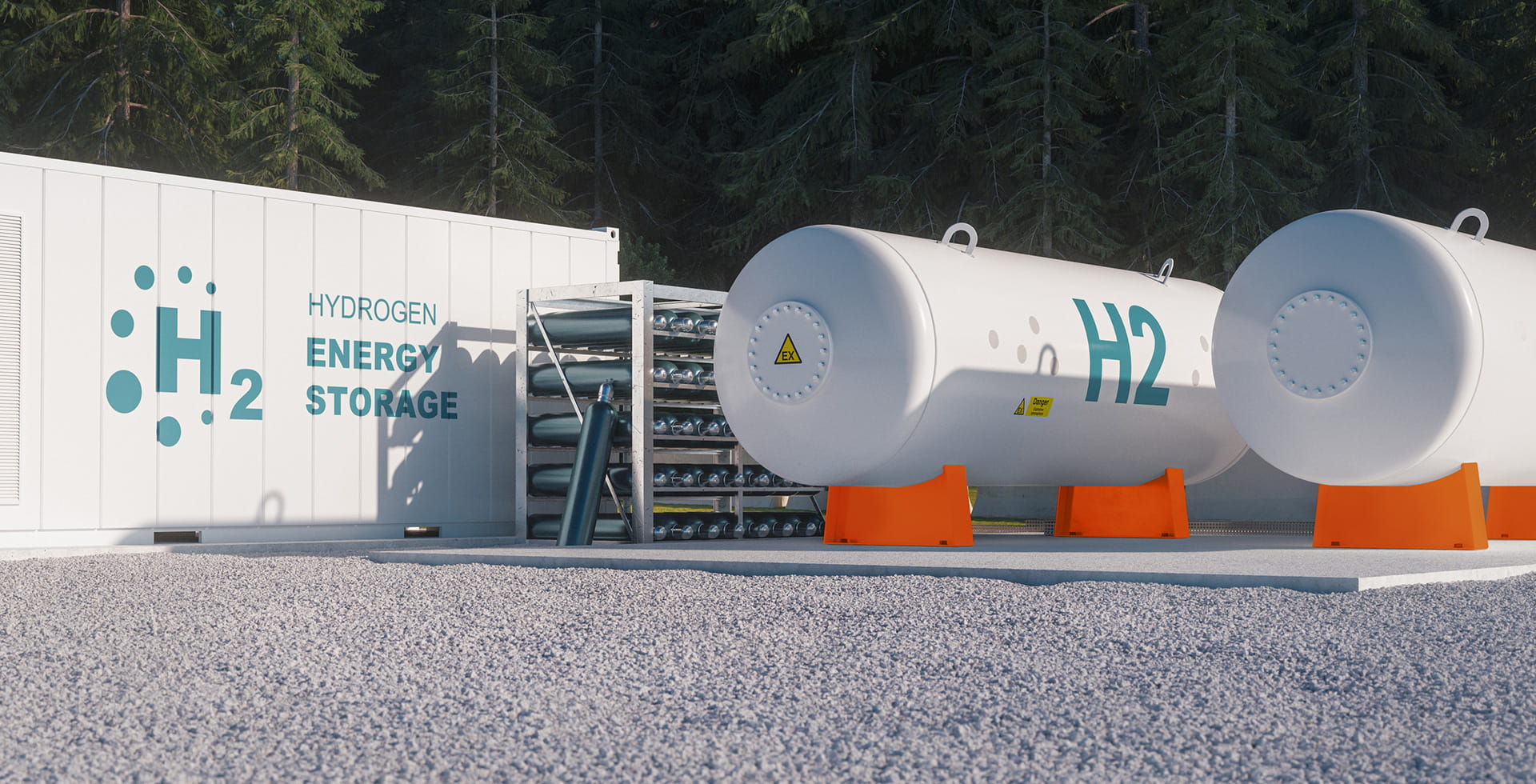Fuelling innovation: how hydrogen can support the shift to renewables

Summary
One of the biggest challenges as the world seeks to transition away from fossil fuels for energy production is how to store the power generated from renewable sources. Renewable energy such as wind and solar power needs to be stored in reliable ways to compensate for its intermittent supply. Hydrogen could be a key part of the answer, creating a boom in innovation around this technology.
Key takeaways:
- Hydrogen, which can be produced through the electrolysis of water, is set to be a critical part of the solution to transitioning away from the world’s reliance on fossil fuels
- Renewable-energy generation can be intermittent – because it relies on factors such as the weather – and hydrogen’s chemical make-up helps store this energy for when it is needed
- While many challenges must be overcome before hydrogen is widely adopted – including answering questions over its efficiency – it could provide significant investment opportunities as a transformative technology
In December 2019 in Kobe, Japan, the world’s first liquefied hydrogen carrier was launched. The ship, called the “Suiso Frontier”, can transport up to 1,250m3 of hydrogen – about half the size of an Olympic swimming pool – at -253°C. While this news went unnoticed by much of the world, it was a critical milestone: it marks a beginning of a key part of the shift away from fossil fuels and towards a carbon-free economy.
Why? Because hydrogen has the chemical properties to store energy for later use. The “decoupling” of power generation and consumption is one of the big challenges facing green energy such as wind or solar. These are intermittent sources of power because they depend on factors such as the weather. So because they can’t produce a continuous stream of electricity, the power they generate needs to be stored for later, when it is needed. And hydrogen is potentially part of the answer.
![]()
![]()
![]()
![]()
![]()
![]()
![]()
How it works
Hydrogen is produced through the electrolysis of water, where hydrogen and oxygen are separated. Water is an excellent “raw material” as it is generally readily available and non-polluting. Carbon-free power from wind, solar or other renewable energy sources can be used to turn the water supply into hydrogen in a “clean” way. Then, when the clean energy is needed, the hydrogen can be transformed into electricity through a fuel cell or turbine. This is very similar to how natural gas is used for electricity generation, heating and various industrial processes.
Hydrogen can be used to solve some of the biggest problem presented by the “energy transition” towards a non-fossil-fuel-powered economy:
- Hydrogen can provide clean energy for polluting industries like cement or steel, which still rely heavily on fossil fuels but need massive amounts of energy that are hard to obtain from other low-emission sources.
- One of the challenges of renewable power generation is that it tends to destabilise existing power supply grids, which are built for dependable and predictable methods of generation. Hydrogen can provide storage in times of overproduction and help renewables constitute a higher percentage of the total power-generation mix.
- Hydrogen is highly flammable – similar to fossil fuels like natural gas. But that means the infrastructure and technology needed – for example, pipelines and fuelling stations – is also similar, so it should be easier to promote the use of hydrogen at scale.
The flip side of hydrogen
Hydrogen has many advantages as well as some significant shortcomings:
- It must be transported at high pressure and very low temperatures, and the energy required for cooling alone can make it less cost effective.
- Some aspects of the hydrogen value chain are inefficient. For example, when producing hydrogen through water electrolysis, only 80% of the electricity used is transformed into hydrogen. The balance is lost through heat or friction.
- The way hydrogen is consumed can also be inefficient. Using hydrogen in a fuel cell to generate electricity is only around 60% energy efficient1. This figure can fall to as little as 29% when hydrogen is burned in a hydrogen turbine2. In comparison, a lithium ion battery has an energy efficiency of roughly 80% over 10 years of usage.3
Hydrogen is a vital part of the solution
Hydrogen isn’t a perfect energy-storage solution. But while batteries might be more energy efficient than hydrogen, for example, the capacity of a battery pack is limited. Hydrogen can store larger amounts of energy at much lower cost than batteries, making it a good solution for wind-turbine parks or grid applications.
But it’s not an either/or proposition. For a successful energy transition, the ultimate answer may well be a mix of different storage technologies – including batteries and hydrogen. And no storage solution will save any carbon emissions as long as power generation continues to rely heavily on fossil fuels, but better storage can boost a broad-based roll-out of renewables. Currently the energy generation mix still relies heavily on coal, gas and nuclear (see chart). A meaningful reduction of carbon emissions will require a much higher proportion of renewables.
According to the International Renewable Energy Agency (IRENA), a threefold increase in the installed capacity for onshore wind and a tenfold increase in offshore wind will be necessary in the next decade to stay within the 2-degree global warming objective by 2050.4 Without storage technologies like hydrogen, such a massive build-out of renewables would not make sense and could even imperil the world’s power grids.
To combat climate change successfully, the world needs to shift its power generation mix
Source: IE, Bloomberg NEF.
So the “Suiso Frontier” could indeed mark a starting point for the hydrogen economy and unleash unprecedented growth in renewable capacity over the coming decades. Japan could be a leader in developing new hydrogen technologies. As the country where this groundbreaking ship was launched, Japan seems determined to showcase its industrial ability in hydrogen – including at the Olympic Games in 2021, where the Olympic torch will run on hydrogen. Meanwhile, the first phase of the European Union’s Hydrogen Strategy calls for the installation of at least six gigawatts of renewable hydrogen electrolysers in the EU, and the production of up to one million tonnes of renewable hydrogen by 2024. It envisages the large-scale deployment of renewable hydrogen technologies across all hard-to-decarbonise industries by 2050.
Clearly, while hydrogen is a piece of a much larger energy-transition puzzle, investors will have a growing number of opportunities to invest in this potentially transformative technology.
David Finger
Senior Portfolio Manager, Global Thematic Equity
 |
About the United Nations Sustainable Development Goals The United Nations Sustainable Development Goals are 17 goals that were adopted by all United Nations Member States in 2015 as part of the 2030 Agenda for Sustainable Development, which set out a 15-year plan to achieve the goals. The UN SDGs address a range of social needs, including education, health, social protection and job opportunities, while tackling climate change and environmental protection. They serve as a framework to promote prosperity while protecting the planet to achieve a better and more sustainable future for all. |
Growing seeds: how investors can play a role in enhancing food security

Summary
The coronavirus pandemic refocused our attention on the value of food, with the question “how to grow seeds” trending on the internet. Yet even before the pandemic hit, the entire system of providing people with food was hugely inefficient. And without action, it will likely only get worse. The good news is that the private sector can address the UN’s Sustainable Development Goals by investing in innovations that improve the sustainability of the food economy – with the goal to do it profitably.
Key takeaways:
- Millions of people live in the shadow of hunger, but a third of all food goes to waste throughout the supply chain
- Our current food-production system is environmentally harmful, so the answer isn’t simply to produce more food in the same way
- The world needs investment in innovative systems to improve the sustainability of our food supply – and aligning with the UN Sustainable Development Goals can provide helpful guidance about where to invest for better food security
- Data-driven precision agriculture, “vertical farming” methods and aquaponics can improve how food is grown, while elsewhere companies are pioneering more sustainable packaging methods and reducing food waste
- Creating alternatives to animal protein – and promoting wellness in people and animals – can address both nutritional and environmental challenges










